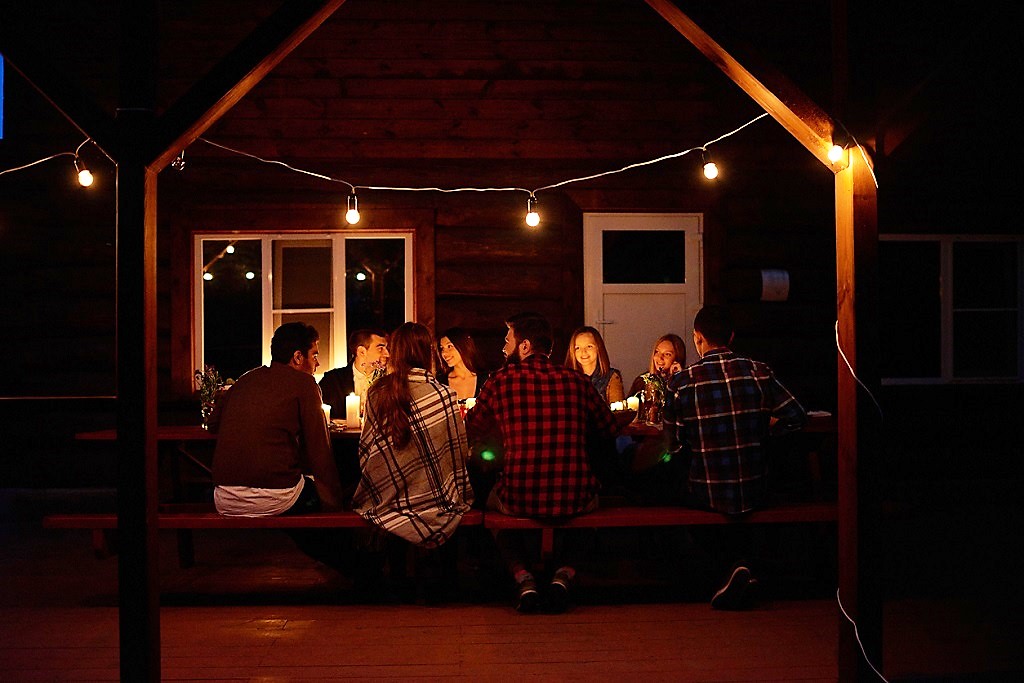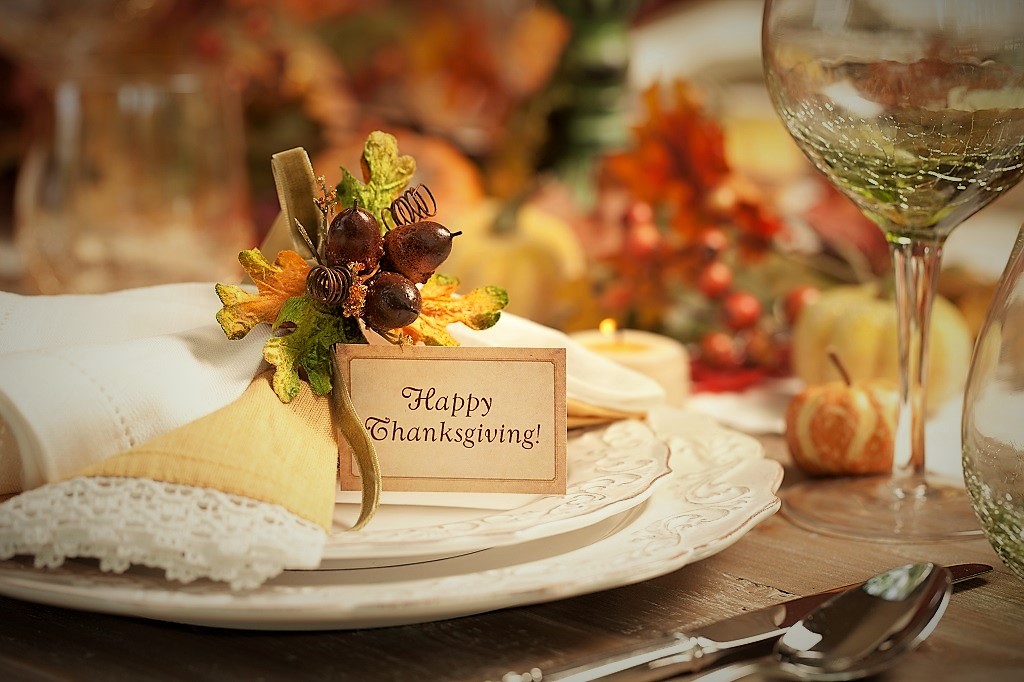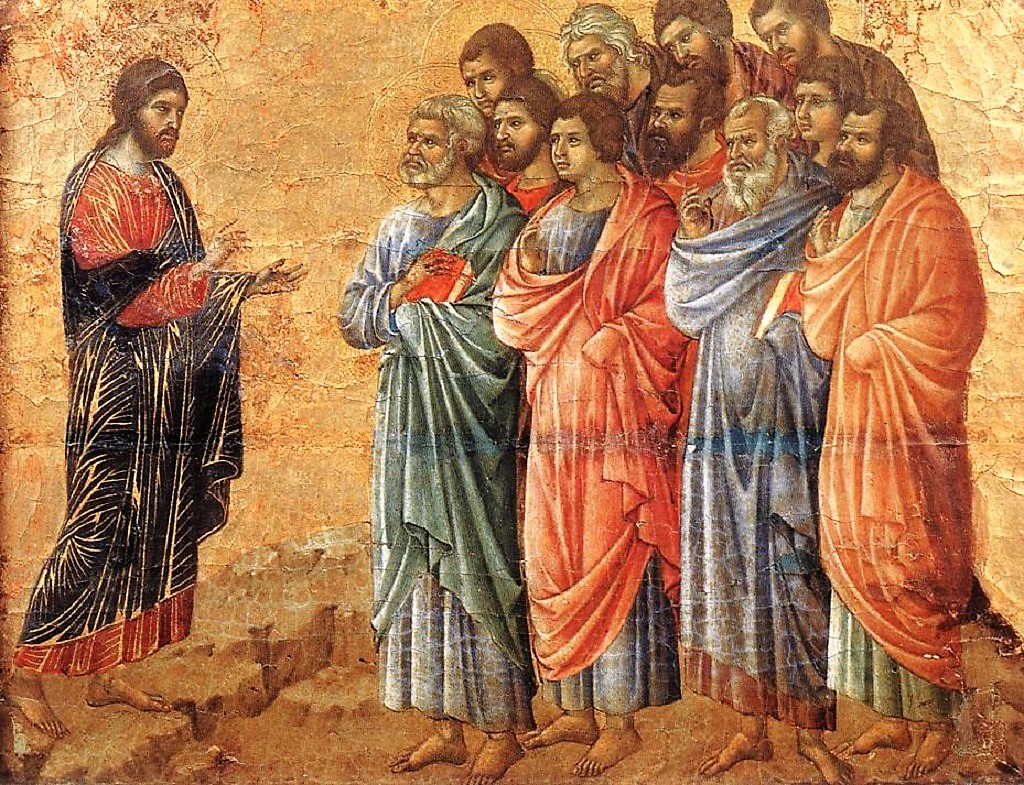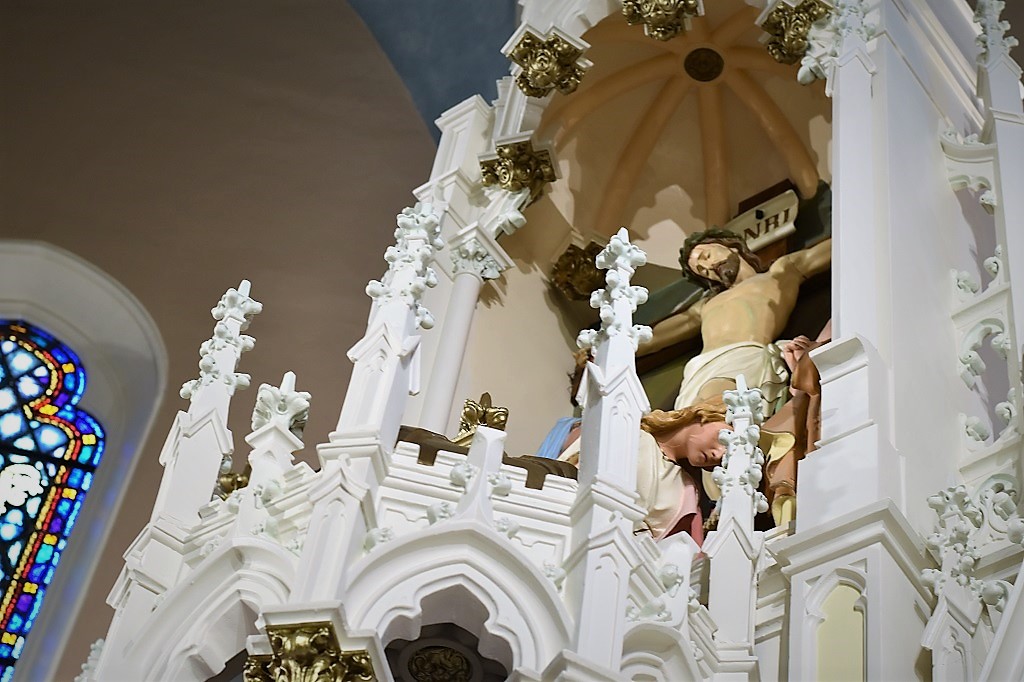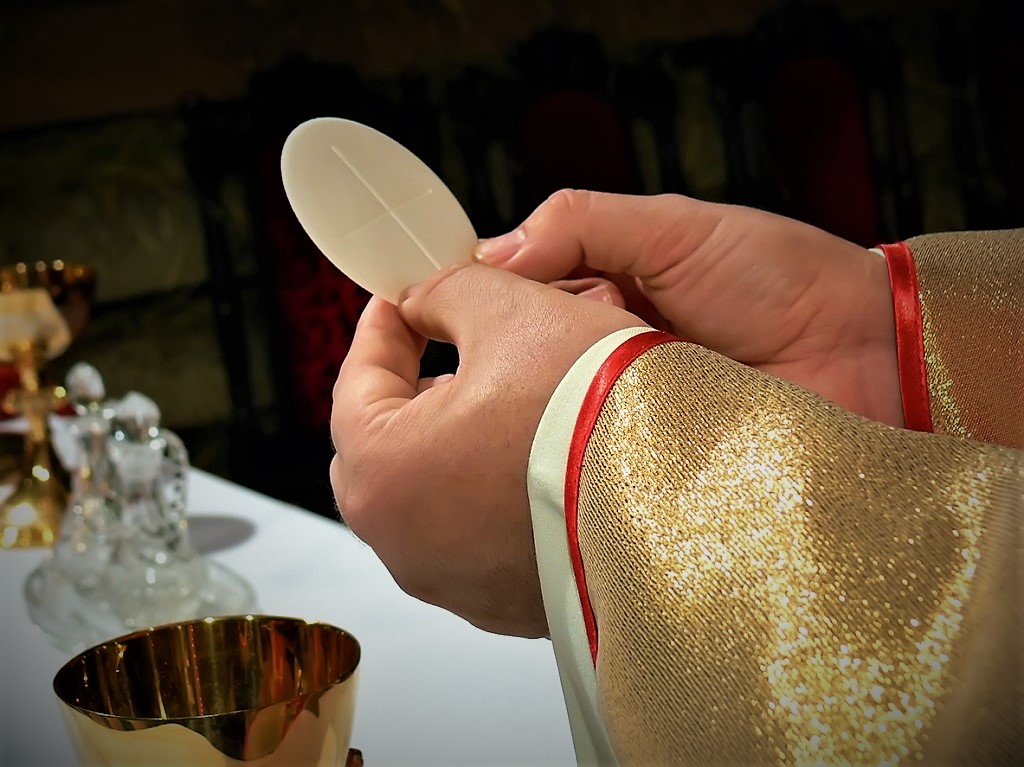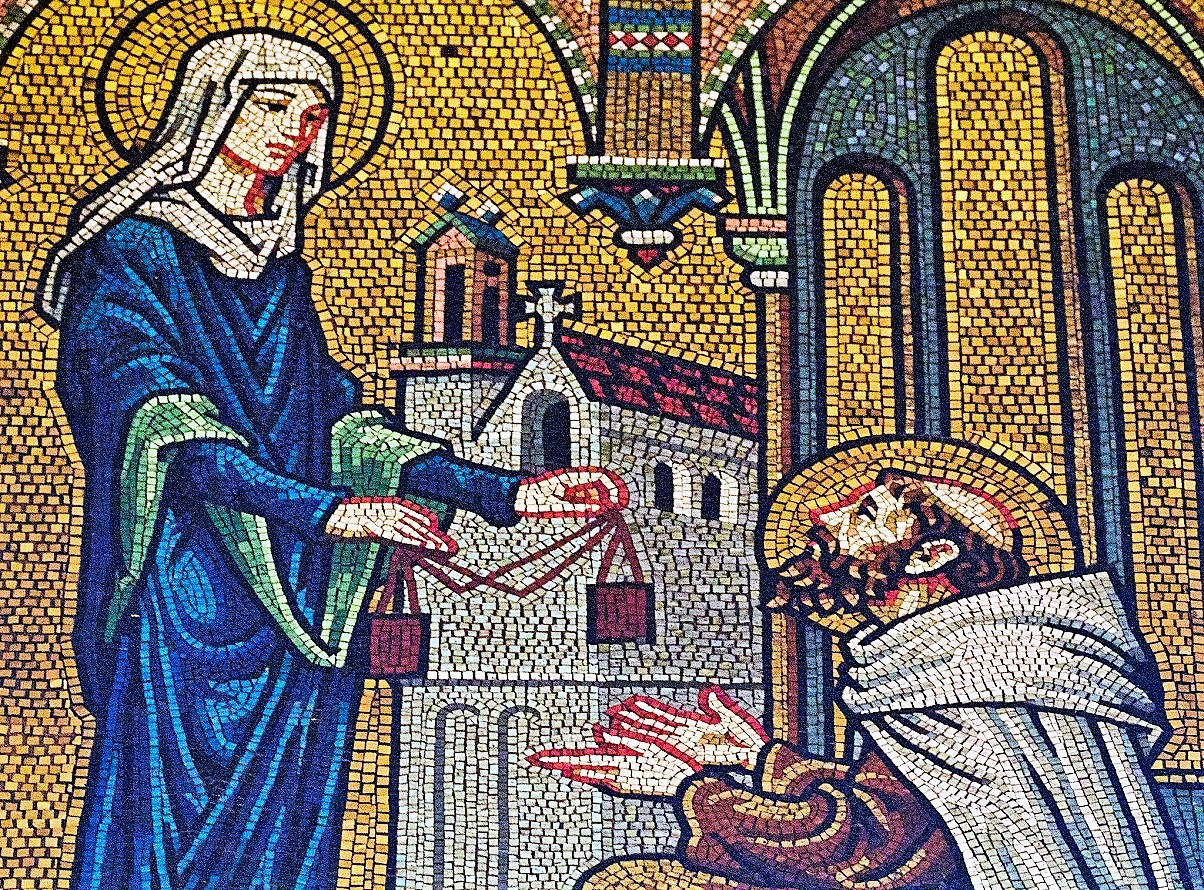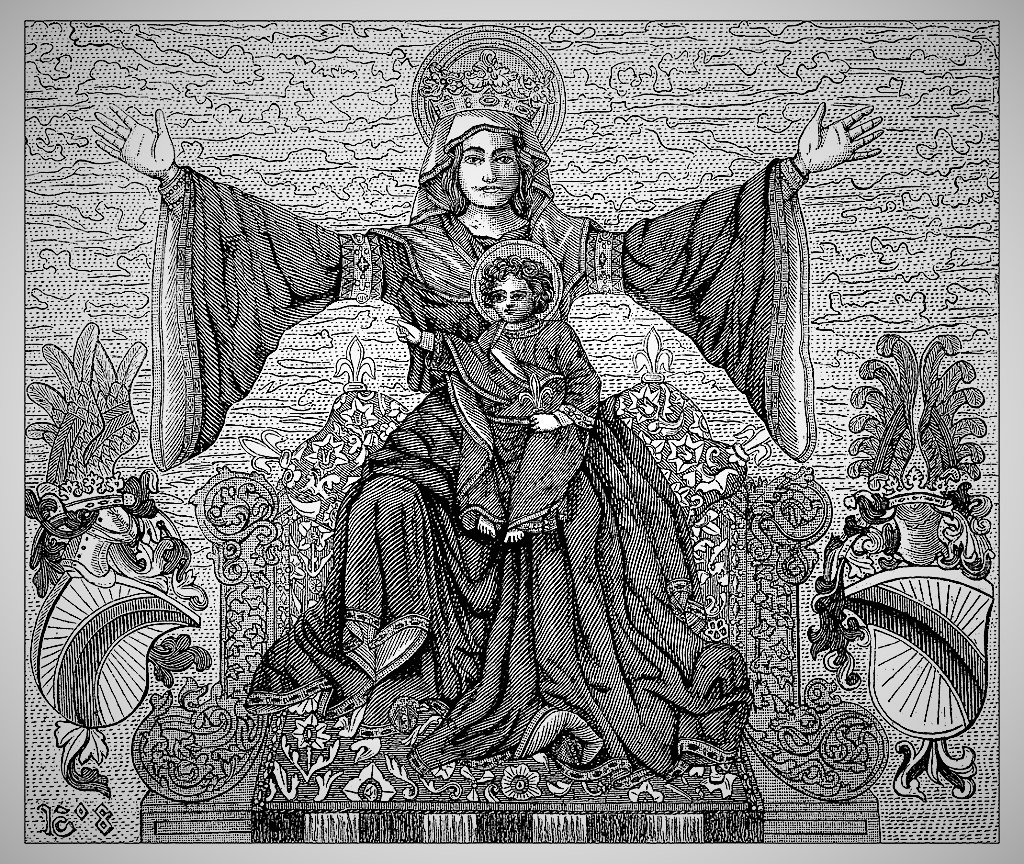Test
First Sunday of Advent: Inviting Christ Into Our Lives
Sunday, December 3, 2017, marks the first Sunday of Advent, and the first Sunday of the new liturgical year. Advent is the time when we prepare for the coming of Christ. We remember the historical event of the birth of Jesus, Son of God and Son of Mary, yet we also look forward to Christ’s return. The Gospel for this Sunday, from Matthew, reminds us to be alert to this event.
How exactly do we prepare for Christ? How do we invite Him in? Do we even really want to invite Him in? It’s all well and good to meet Jesus on Sundays – sort of like a weekly coffee date with a friend. But you don’t invite your friend to move in with you! No, it’s really far easier to just keep Jesus “contained,” in church, on Sundays.
In the book, With Burning Hearts: A Meditation on the Eucharistic Life, priest-contemplative Henri Nouwen says that the moment of Eucharist is THE single most important decision of our lives: Are we going to allow Christ in? It is a decision to make Christ part of your life, every moment of every day, to remove the walls you have placed around Him.
Jesus is a very interesting person; his words are full of wisdom. His presence is heart-warming. His gentleness and kindness are deeply moving. His message is very challenging. But do we invite him into our home? Do we want him to come to know us behind the walls of our most intimate life? Do we want to introduce him to all the people we live with? Do we want him to see us in our everyday lives? Do we want him to touch us where we are most vulnerable? Do we want him to enter into the back rooms of our homes, rooms that we ourselves prefer to keep safely locked? Do we truly want him to stay with us when it is nearly evening and the day is almost over?
Christ, you see, is not meant to be contained. He is not meant to be a weekly visitor or a standing coffee date which one can easily cancel if something comes up. He is not even meant to be a boarder in our home; a person who rents a room but is seldom seen or heard.
There is a reason that we encounter Christ around the table, the altar. The act of gathering around a table to share a meal is an act of intimacy. Even strangers become friends when they gather together to not simply eat, but to enjoy the food, the company, the joy of elevating basic human nourishment to an occasion of joy.
Yet no hostess in the world would think of handing out coats to the guests just as the last mouthful has been consumed: “Oh! Out to you go! Been lovely to see you, but time to get!” We would be shocked – and rightly so. No, part of the invitation to the table is the chance to linger and further enjoy the company of those gathered. And if the weather has turned bad while the meal was being enjoyed, the host and hostess would find blankets and pillows and places for everyone to rest their heads.
So too, you also must be prepared, for at an hour you do not expect, the Son of Man will come. – Mt. 24:44
As we prepare for the holy season of Advent, let us begin by asking ourselves: Do I REALLY want Christ to be part of my entire life? Am I only giving Him a sliver of my time? Where do I deliberately keep Christ from entering? Why? Is Christ truly a guest in my home, my life?
A Blessed Thanksgiving
Today, Americans of every race, creed, religion and belief gather to give thanks. It is a day for family and friends, for feasting and for favor.
In 1863, when our country was literally torn apart by civil war, President Abraham Lincoln proclaimed a day of thanks. Even in the midst of great conflict and animus, Lincoln prayed that every American be able to give thanks.
The year that is drawing towards its close, has been filled with the blessings of fruitful fields and healthful skies. To these bounties, which are so constantly enjoyed that we are prone to forget the source from which they come, others have been added, which are of so extraordinary a nature, that they cannot fail to penetrate and soften even the heart which is habitually insensible to the ever watchful providence of Almighty God. In the midst of a civil war of unequalled magnitude and severity, which has sometimes seemed to foreign States to invite and to provoke their aggression, peace has been preserved with all nations, order has been maintained, the laws have been respected and obeyed, and harmony has prevailed everywhere except in the theatre of military conflict; while that theatre has been greatly contracted by the advancing armies and navies of the Union. Needful diversions of wealth and of strength from the fields of peaceful industry to the national defence, have not arrested the plough, the shuttle or the ship; the axe has enlarged the borders of our settlements, and the mines, as well of iron and coal as of the precious metals, have yielded even more abundantly than heretofore. Population has steadily increased, notwithstanding the waste that has been made in the camp, the siege and the battle-field; and the country, rejoicing in the consciousness of augmented strength and vigor, is permitted to expect continuance of years with large increase of freedom. No human counsel hath devised nor hath any mortal hand worked out these great things. They are the gracious gifts of the Most High God, who, while dealing with us in anger for our sins, hath nevertheless remembered mercy. It has seemed to me fit and proper that they should be solemnly, reverently and gratefully acknowledged as with one heart and one voice by the whole American People. I do therefore invite my fellow citizens in every part of the United States, and also those who are at sea and those who are sojourning in foreign lands, to set apart and observe the last Thursday of November next, as a day of Thanksgiving and Praise to our beneficent Father who dwelleth in the Heavens. And I recommend to them that while offering up the ascriptions justly due to Him for such singular deliverances and blessings, they do also, with humble penitence for our national perverseness and disobedience, commend to His tender care all those who have become widows, orphans, mourners or sufferers in the lamentable civil strife in which we are unavoidably engaged, and fervently implore the interposition of the Almighty Hand to heal the wounds of the nation and to restore it as soon as may be consistent with the Divine purposes to the full enjoyment of peace, harmony, tranquillity and Union.
May we all enjoy a Thanksgiving of abundance, of reverence, of mercy and the tender care of those who are most in need.
The Ascension: Going Home
Sister Wendy Beckett is a Catholic hermit who lives in England. She also had a long-running BBC television show on art, that drew a large and delighted audience. Since today is Ascension Thursday (and still a holy day of obligation in parts of the world), I thought we could listen to Sister Wendy’s thoughts on Duccio’s Appearance on the Mountain in Galilee, the painting that accompanies this blog post.
[The painting] shows Jesus before he makes any movement upward. He is speaking with that unearthly authority that so riveted all who heard him. It is their word that will convert the waiting nations. Is it they, up to now only followers, listeners to Jesus, who are now to take the pulpit and teach others, baptize others, do for them what Jesus has done in their own lives…
Jesus has longed for this day…[there] is the quiet statement, made in prayer to the Father, “I am coming to you.” Coming to the Father has been the driving force of Jesus’ life. That is where he is at home, that is where he belongs.
Those words give us pause. Of course Jesus must have been, in essence, homesick. How weary He must have been of His mortal body, a body that was fully divine, but also fully human. Even more, He was separated for so long from His Father, a Father with whom He is joined in an unimaginable way. Indeed: He wanted to go home!
Now, the Apostles must have left that mountain downcast. Their Lord and Master, who miraculously rose from the dead, was now gone … and not returning. Yes, He promised to send His Spirit upon them, but they must have felt great loss.
However, underneath that very understandable human grief, there was something else: joy.
Yes, joy. Why? Because Christ’s Ascension solidified their belief that Heaven awaited them as well.
In a sermon to commemorate today’s solemnity St. Leo the Great said: “Today we are not only made possessors of Paradise but with Christ we have ascended, mystically but also really, to the highest Heavens and have won through Christ a grace more wonderful than the one we had lost.”
The Ascension strengthens and nourishes our hope of attaining Heaven. It invites us always to lift up our heart, as the preface of the Mass says, and seek the things that are above. Our hope is very great because Christ himself has gone to prepare a dwelling place for us.
Most of us know what it is like to say a final good-bye to someone we love. Our grief can be overwhelming! But when we are assured that our loved one died a holy death, there is also joy. We trust God’s mercy and love; we pray that our loved one is now home with God, free from the pain of this mortal life.
It is hard to imagine the Ascension. It stretches the limits of our imagination as to how Jesus rose from the grass and rocks of that mountain top, enveloped in a cloud that melted into a vast sky. What is not hard to imagine is how the Apostles left that mountain: saddened, but filled with hope and joy. Their Lord, whom they loved, was now home where He belonged, and that home awaited them as well.
Gladden us with holy joys, almighty God,
and make us rejoice with devout thanksgiving,
for the Ascension of Christ your Son
is our exaltation,
and, where the Head has gone before in glory,
the Body is called to follow in hope.
Through our Lord Jesus Christ, your Son,
who lives and reigns with you in the unity of the Holy Spirit,
one God, for ever and ever. Amen.
From Here to Eternity: What do we know about Heaven?
Most people like to think that Heaven exists. Some of us try earnestly to get there. And everyone from Hollywood movie makers to philosophers to theologians have opinions about Heaven. But what do we really know about Heaven?
Anyone who’s opinion is worth anything on the topic will tell you: “We don’t know much about Heaven. It’s sort of like asking us to describe God – any human effort falls so far short as to be comical.” But that doesn’t mean we know nothing about Heaven. Philosopher, author and Boston College professor Peter Kreeft have thankfully given us a Q & A that is helpful here.
Now, some of these questions are quite child-like, but the answers are not. (And remember, Christ told us to be child-like in faith, so this is a good place to start!)
Yes, but with a different kind of bigness. Now, space contains us, confines us, defines us. But we can transform space into place by humanizing it, spiritualizing it. A house becomes a home, a space becomes a place, by our living in it. Heaven will be both as intimate and as unconfining as our spirits want.
No one will think it too small or too large. In a sense, it will be in us rather than we in it—not in the sense that it will be subjective, but in the sense in which stage settings and props are in a play, or part of a play, rather than the play being in or part of the setting.
Hmmm, that still sounds very … much like a philosopher! Here is how I look at this, and maybe you’ll find it helpful: Imagine that – as good as this life is and can be – Heaven will be like freedom to a prisoner. While we can make a life in a 6×9 cell, and we might even flourish, it is still prison. We are confined, limited. Heaven will be like freedom: no limits, but all good.
Of course, for many of us, this life is tough. We bear scars, both physically and emotionally. If we reach old age, our bodies show the wear and tear of life, with stooped shoulders and creaky joints.
What kind of bodies will we have in Heaven?
Gnostics of all kinds (Platonists, Buddhists, Hindus, Spiritualists, Manichaeans) say we will become pure spirits, angels, for they do not know the dogma of Creation. Pagans and Muslims say we will have earthly bodies and harems or happy hunting grounds.
Christians say we will have transformed bodies, but real, physical bodies, as Christ had after his resurrection. His body could be touched and could eat. Yet it could come and go as he pleased, with neither walls nor distance as an obstacle. It was the same body he had before he died, and it was recognized as such by his friends. Yet it was so different that at first they did not recognize him. I think our new resurrection body will be related to the body we have now in the same way that our current body is related to the body we had in our mothers’ wombs. If a fetus saw a picture of itself at the age of twenty, it would at first not recognize itself, so unforeseen and surprisingly new would it be. Yet it is the same self, even the same body, now grown radically more mature.
When we die, we do NOT become angels. Angels are a completely different type of creature from humans, and while we have some things in common, we no more become angels in Heaven than we would become giraffes.
It is nice to know that we will still be ourselves in Heaven, but transformed from our earthly bodies. I don’t know about you, but I’m looking forward to a transformed body!
Of course, the most important question regarding Heaven is one all of humanity needs to ponder:
How do you get to Heaven?
This is the most important question anyone can ask. The answer has already been given: It is free. “Let him who is thirsty come, let him who desires take the water of life without price” (Rev. 22:17). Faith is the act of taking.
It sounds crazy, too good to be true. But it makes perfect sense. For God is love. Love gives gifts, gives itself. God gives himself, his own life, membership in his family. We are made “partakers of the divine nature” (2 Peter 1:4). For God is pure love, and pure love has no admixture of stinginess in it.
Heaven, you see, is ours to lose. God has already granted us life in Him for all eternity. We humans can take it … or leave it. Far too many choose the latter. We refuse the gift. Perhaps, this side of Heaven, it is the poets and saints who will come closest to telling us what Heaven is. St. Robert Southwell, Jesuit priest and martyr, said,
The path to Heaven is narrow, rough and full of wearisome and trying ascents, nor can it be trodden without great toil; and therefore wrong is their way, gross their error, and assured their ruin who, after the testimony of so many thousands of saints, will not learn where to settle their footing.
St. Faustina’s vision of Heaven seems to verify St. Robert Southwell’s thoughts:
I saw two roads. One was broad, covered with sand and flowers, full of joy, music and all sorts of pleasures. People walked along it, dancing and enjoying themselves. They reached the end without realizing it. And at the end of the road there was a horrible precipice; that is, the abyss of hell. The souls fell blindly into it; as they walked, so they fell. And their number was so great that it was impossible to count them. And I saw the other road, or rather, a path, for it was narrow and strewn with thorns and rocks; and the people who walked along it had tears in their eyes, and all kinds of suffering befell them. Some fell down upon the rocks, but stood up immediately and went on. At the end of the road there was a magnificent garden filled with all sorts of happiness and all these souls entered there. At the very first instant they forgot all their sufferings.
St. Faustina went on to say that Heaven was filled with “unconceivable beauties.”
Ultimately, we must trust God, who has promised us Heaven, where we will see God “face to face:
Then the angel showed me the river of life-giving water, sparkling like crystal, flowing from the throne of God and of the Lamb down the middle of its street.
On either side of the river grew the tree of life that produces fruit twelve times a year, once each month; the leaves of the trees serve as medicine for the nations.
Nothing accursed will be found there anymore.
The throne of God and of the Lamb will be in it, and his servants will worship him.
They will look upon his face, and his name will be on their foreheads.
Night will be no more, nor will they need light from lamp or sun, for the Lord God shall give them light, and they shall reign forever and ever.
 Elise Hilton is an author, blogger and speaker. Her role at Diocesan Publications is Editor & Writer with the Marketing Team. She has worked in parish faith formation and Catholic education for over 30 years. A passionate student of theology, Elise enjoys sharing her thoughts on parish communication, the role of social media in the Church, Franciscan spirituality and Catholic parenting. To enquire about booking her as a speaker, please contact her at ehilton@diocesan.com.
Elise Hilton is an author, blogger and speaker. Her role at Diocesan Publications is Editor & Writer with the Marketing Team. She has worked in parish faith formation and Catholic education for over 30 years. A passionate student of theology, Elise enjoys sharing her thoughts on parish communication, the role of social media in the Church, Franciscan spirituality and Catholic parenting. To enquire about booking her as a speaker, please contact her at ehilton@diocesan.com.
A Few Facts About The Holy Spirit
If you love me, you will keep my commandments.
And I will ask the Father,
and he will give you another Advocate to be with you always,
the Spirit of truth, whom the world cannot accept,
because it neither sees nor knows him.
But you know him, because he remains with you,
and will be in you. (Jn. 14:15-20)
Of all the doctrines of the Faith, the Holy Spirit is probably one of the toughest for us to understand. The Third Person of the Trinity can seem vague, amorphous, unclear. Some of us have the image of a dove (which is Scriptural), but that isn’t wholly accurate. We do not have a “face” to go with the name, in a manner of speaking. Of course, it is a mystery – meaning it is something we will not fully understand this side of Heaven, if ever.
However, that does not mean we don’t know anything about the Holy Spirit. Here are some facts:
- According to Scott Hahn, we get much of what we can know about the Spirit from the Book of Wisdom:
It was common for Jews of the time to view divine Wisdom as a person (or personification) distinct from Yahweh, and Christians often interpreted the Bible’s wisdom passages as referring to the Holy Spirit. It was a reasonable surmise. For example, in the Book of Wisdom, chapters 7–9, God’s Wisdom is referred to as “holy spirit,” and then described in terms that are strikingly divine (“all-powerful,” “all-knowing,” “overseeing all,” and “more mobile than any motion,” 7:22–23). And, since the Hebrew word for Wisdom, hokmah, is also feminine, Wisdom was addressed in bridal terms (“irresistible,” “more beautiful than the sun,” 7:22, 29).
- We need the Holy Spirit in order to comprehend God’s thoughts (1 Cor. 2:11), and the Spirit has spoken through the prophets in order to help us gain this understanding.
- St. Catherine of Siena gives us this beautiful analogy: “Enrich your soul in the great goodness of God: The Father is your table, the Son is your food, and the Holy Spirit waits on you and then makes His dwelling in you.”
- We know we are “sealed” in the Spirit at Confirmation. That “mark,” says St. Paul, is made because we believe in Christ Jesus.
- The Holy Spirit is a gift-giver! He shares with us wisdom, understanding, knowledge, counsel, fortitude, piety and fear of the Lord. Of course, like any gift, we can choose to use these or we can stuff them back in the proverbial box, shove them in a dark corner of our closet and forget about them. The Spirit gives the gifts, but He will never strong-arm us into using them.
- And the gifts just keep on giving! The Holy Spirit (just as St. Catherine of Siena said) brings to us luscious fruit as our “waiter:” charity, joy, peace, patience, kindness, goodness, long-suffering, humility or gentleness, fidelity or faithfulness, modesty, continence or self-control and chastity. Again, we can give thanks and eat, or we can tell the waiter to take it back.
While we may not fully understand the Holy Spirit, it is clear from just these few thoughts that the Spirit is an abundant giver, powerful, and willing to serve us. The Holy Spirit is the love of God the Father and God the Son, poured out into this Third Person of the Trinity, speaking to us through Scripture and the Church. Yes, the Holy Spirit is a mystery – but a mystery willing to reveal itself bit-by-bit as we pray and study and contemplate.
Spirit of life, by whose power the Word was made flesh
in the womb of the Virgin Mary, the woman of attentive silence,
make us docile to the promptings of your love
and ever ready to accept the signs of the times
which you place along the paths of history.
Come, Spirit of love and peace!
To you, Spirit of love,
with the Almighty Father and the Only-Begotten Son,
be praise, honour and glory
for ever and ever. Amen.
[Original art by Waiting for the Word.]
 Elise Hilton is an author, blogger and speaker. Her role at Diocesan Publications is Editor & Writer with the Marketing Team. She has worked in parish faith formation and Catholic education for over 30 years. A passionate student of theology, Elise enjoys sharing her thoughts on parish communication, the role of social media in the Church, Franciscan spirituality and Catholic parenting. To enquire about booking her as a speaker, please contact her at ehilton@diocesan.com.
Elise Hilton is an author, blogger and speaker. Her role at Diocesan Publications is Editor & Writer with the Marketing Team. She has worked in parish faith formation and Catholic education for over 30 years. A passionate student of theology, Elise enjoys sharing her thoughts on parish communication, the role of social media in the Church, Franciscan spirituality and Catholic parenting. To enquire about booking her as a speaker, please contact her at ehilton@diocesan.com.
Trust in Jesus: 4 Reasons Catholics Are Full of Hope
On the 6th Sunday of Easter, we hear from St. Peter in the second reading. Since it is St. Paul who dominates the writings of the New Testament (outside of the Gospels,) it is good to hear from St. Peter. This section of 1st Peter focuses on hope.
Hope, the Church teaches, is one of the three theological virtues (the others are faith and charity.) Hope is:
… the theological virtue by which we desire the kingdom of heaven and eternal life as our happiness, placing our trust in Christ’s promises and relying not on our own strength, but on the help of the grace of the Holy Spirit.
St. Peter makes it clear that hope is a hallmark of a person who follows Christ.
Always be ready to give an explanation to anyone who asks you for a reason for your hope, but do it with gentleness and reverence, keeping your conscience clear, so that, when you are maligned, those who defame your good conduct in Christ may themselves be put to shame. (1 Pt. 3:15-16)
It’s rather odd that Peter is so focused on “hope,” since the young Church was being persecuted. Peter and the other Apostles were run out of town, imprisoned, brought up on various charges. But they went forward, with great hope.
As modern Christians, we might be tempted to abandon hope. Our world certainly is dismal. Christians are the most persecuted religion across the globe. Violence, culture wars, and just plain old evil seems to be winning the war for souls.
But we have hope. And we need to be able to tell anyone who asks why we are so hopeful. Here are just four reasons:
- The first and foremost reason for hope is Christ. We believe (just as we say at most Masses) that Christ became Man, took our sins upon Himself, died and then rose again. As St. John Paul II said, “We are an Easter people, and alleluia is our song.”
- We have been promised Heaven. If we love God and do His will, we gain eternal happiness with Him in Heaven. That’s an immense reality, and the source of much hope.
- We are not in this alone! Yes, our world is scary and dangerous and sometimes evil, but we are never alone! First, Christ promised He would never leave us along (see John 14.) Further, we have a community of brothers and sisters in Christ to lean on, to help us live better and holier lives, and to pray with and for us.
- The sacraments are a source of hope. Because we are baptized in the name of the Father, the Son and the Holy Spirit, we live in Christ and He is us. St. Paul says, God chose to make known the riches of the glory of this mystery among the Gentiles; it is Christ in you, the hope for glory. (Col. 1:27.) In the Eucharist, Christ gives His very Body and Blood; we consume and He dwells in us.
Let us live in such a way that all may see the hope we have as Christians. May our hope gives others hope as well, as we make known Christ Jesus.
Power To Redeem: The Blood of Jesus
What’s your type?
Anyone who remembers basic biology or who has watched a medical drama knows that humans have different blood types. When someone loses blood due to accident or injury, and that person’s blood needs to be replaced, the medical team takes care to “type” the blood, so as to match it with donated blood. A person given the wrong blood type can potentially lose their life. (Some people, those with “O” type blood are universal donors; they can supply blood to any other person, regardless of type.)
Humans cannot live without blood. Why we were created this way, only God knows, but it is fact. Without blood, we cease to exist.
As a Church, we are a living organism. We are the Body of Christ. Also, Scripture, Tradition and the saints call the Church the Bride of Christ:
The Church is the spotless bride of the spotless Lamb. “Christ loved the Church and gave himself up for her, that he might sanctify her.” He has joined her with himself in an everlasting covenant and never stops caring for her as for his own body.
What one of us would not give our blood for the life of a cherished love one? Many of us donate blood for people we will never meet this side of Heaven. We do this because we understand how vital it is to life.
Christ: the eternal donor
Christ knew the value of blood to humanity. He made it clear, at the Last Supper, that he was sacrificing His very Body and Blood for the life of the Church. He poured out that blood the following day, as He was beaten and battered, whipped and kicked, and finally crucified. Monsignor Romano Guardini:
Christ the intermediary [between us and God the Father] is a sacred living artery through which divine purity and forgiveness flow; through the establishment of the Eucharist he becomes a permanent artery, supplying all the generations with the superabundance of divine life. [The Lord]
I don’t know about you, but that puts me into a state of awe: our God has given His very life’s blood so that we can share in his divinity. As a Church, as baptized Christians, as people of the Eucharist, we receive “transfusions” of life and divinity and purity and forgiveness. Christ holds nothing back. Do we hold back? Are we reluctant to give ourselves wholly to Christ, when He has been generous to us?
St. Catherine of Siena was devoted to the Precious Blood of Christ. She prayed:
Precious Blood, ocean of divine mercy: Flow upon us! Precious Blood, most pure offering: Procure us every grace! Precious Blood, hope and refuge of sinners: Atone for us! Precious Blood, delight of holy souls: Draw us! Amen.
If we cut ourselves off from the “major artery,” that is, Christ, we will perish. If we allow ourselves to receive the transfusion of life, offered by Christ, we will have eternal life. It’s basic biology.
Communion, Community, Mission: Our Easter Meditation
What strange and wonderful days these are, these days between the Resurrection of Christ and His Ascension! He lives, yet is clearly in a bodily form that is not instantly recognizable. He bears the wounds of His crucifixion, yet is able to walk and talk and eat with the Apostles.
There is a sense of urgency. From the moment Mary Magdalen rushed from the empty tomb to tell the Apostles that the Lord was not there, to the men on the road to Emmaus who hustled out to find the Apostles and tell them that they had seen the Lord, to Christ’s compelling promise that, as He left, He would send the Spirit to them. As writer and priest Henri Nouwen says, “Everything has changed.”
We can only imagine the wonder of the Apostles. They were lifted from the very depths of despair as their Master was tortured and killed, and they themselves hid in terror. Yet, now: everything has changed. There is hope and life and joy and awe.
There is something else. On the night before his death, Jesus broke bread and shared wine with the twelve, telling them this was the New Covenant and calling them to share this meal “in memory of me.” Christ was calling them (and us!) not just to a meal, but to a way of life – the Eucharistic life. Again, Henri Nouwen:
The Eucharistic celebration has summarized for us what our life of faith is all about, and we have to go home to live it as long and fully as we can. And this is very difficult, because everyone at home knows us so well: Our impatience, our jealousies, our resentments, and our many little games …
Yet, we forge on. Like the two men on the road to Emmaus who suddenly realized “This is the Christ!” we should be compelled to rush out and share the news with our friends, our family, our community. We should be, as Nouwen points out, on a mission.
The Eucharist is always a mission. The Eucharist that has freed us from our paralyzing sense of loss and revealed to us that the Spirit of Jesus lives within us empowers us to go out into the world and to bring good news to the poor …
For Nouwen, these strange and wonderful days from Resurrection to Ascension flow from communion – that shared meal of Christ’s Body and Blood – to community (as the earliest Christians learns what their roles are to be within this New Covenant) to mission. They come together, they pray, they eat and drink as the Lord directed, they go out and share.
As we continue to celebrate this Easter season, it is good to meditate upon these forty days. How is the Resurrected Christ present to us, to you, to me? Do we recognize Him in the Eucharist? When we are sent forth at the end of Mass, where do we go? What do we do? With whom do we share the Good News? The strange and wonderful days between Easter and Ascension deserve our prayerful attention.
[Quotes from Nouwen are from his book, With Burning Hearts: A Meditation on the Eucharistic Life.]
 Elise Hilton is an author, blogger and speaker. Her role at Diocesan Publications is Editor & Writer with the Marketing Team. She has worked in parish faith formation and Catholic education for over 30 years. A passionate student of theology, Elise enjoys sharing her thoughts on parish communication, the role of social media in the Church, Franciscan spirituality and Catholic parenting. To enquire about booking her as a speaker, please contact her at ehilton@diocesan.com.
Elise Hilton is an author, blogger and speaker. Her role at Diocesan Publications is Editor & Writer with the Marketing Team. She has worked in parish faith formation and Catholic education for over 30 years. A passionate student of theology, Elise enjoys sharing her thoughts on parish communication, the role of social media in the Church, Franciscan spirituality and Catholic parenting. To enquire about booking her as a speaker, please contact her at ehilton@diocesan.com.
Scapulars: Just Another Weird Catholic Thing?
I had a doctor appointment on Monday, and as I left the office, I found a brown scapular with an image of Our Lady of Guadalupe. I couldn’t leave it there, so I picked it up and it’s now hanging in my work space.
It’s certainly true that, for people of other faiths or sects, many Catholic traditions look a little weird. I think the scapular falls into that category. But scapulars have a long, rich history; let’s explore this tradition a bit.
- A scapular, historically, was a long piece of cloth that goes over one’s head, and hangs down the front and back (many religious orders still wear these.) “Scapular” comes from the Latin scapula which means “shoulder.” That makes sense since the scapular lays on one’s shoulders. Today, lay people who wear a scapular usually wear one with two small pieces of wool, connected by cord or ribbon, that hangs down one’s front and back.
- There are many kinds/colors of scapulars. Two popular ones are green scapulars and brown. The green scapular has an image of the Immaculate Heart of Mary and an image of Mary herself, pointing to her Immaculate Heart. Many people relate the green scapular to conversion to a life in Christ. The brown scapular is probably the one most people are familiar with. Tradition says that Mary gave this scapular to St. Simon Stock in the year 1251 AD. Mary’s promise that accompanies this scapular is that the person who wears it with faith “will not suffer everlasting fire.” That may sound like a “Get Out of Hell Free” card, but it’s not. We must be in a state of grace at the moment of death, regardless of what we are wearing at the time.
- Scapulars (like rosaries, holy medals, crosses and crucifixes, for instance) are “sacramentals. “Sacramentals do not confer the grace of the Holy Spirit in the way that the sacraments do, but by the Church’s prayer, they prepare us to receive grace and dispose us to cooperate with it. ‘For well-disposed members of the faithful, the liturgy of the sacraments and sacramentals sanctifies almost every event of their lives with the divine grace which flows from the Paschal mystery of the Passion, Death, and Resurrection of Christ. From this source all sacraments and sacramentals draw their power.'” (CCC 1670) Simply put, a sacramental points us towards and leads us to Christ.
- Scapulars should be blessed by a priest, and like any sacramental that has been blessed, we take great care in how that object is treated. (That’s why I picked up that stray scapular they other day!) Once an object is blessed, and is no longer useful (for instance, the cord on a scapular breaks or a prayer book falls apart) the object can either be buried or burned and then the ashes are buried.
- Many popes have been great “fans” of scapulars, including St. John Paul II:
Pope John Paul II, who is reported to have worn a brown scapular since he was a boy, insisted doctors not remove his scapular during surgery following the assassination attempt in May 1981. Father Mariano Cera, a Carmelite priest, told Inside the Vatican magazine: “Just before the Holy Father was operated on, he told the doctors, ‘Don’t take off the scapular.’ And the surgeons left it on.” In his message to the Carmelites at the 750th anniversary of the bestowal of the scapular, Pope John Paul II said those who wear the scapular — or habit, as he called it — dedicate themselves to the service of Our Lady for the good of the whole Church. “Devotion to her,” he continued, “cannot be limited to prayers and tributes in her honor on certain occasions, but must become a ‘habit,’ that is, a permanent orientation of one’s own Christian conduct, woven of prayer and interior life, through frequent reception of the sacraments and the concrete practice of the spiritual and corporal works of mercy.”
While scapulars may be unfamiliar to many people (Catholics included!), they are items that can be constant reminders that we “have put on Christ” in our baptismal promises. Scapulars, like all sacramentals, can keep us “tuned in” to Christ, all day, every day.
 Elise Hilton is an author, blogger and speaker. Her role at Diocesan Publications is Editor & Writer with the Marketing Team. She has worked in parish faith formation and Catholic education for over 30 years. A passionate student of theology, Elise enjoys sharing her thoughts on parish communication, the role of social media in the Church, Franciscan spirituality and Catholic parenting. To enquire about booking her as a speaker, please contact her at ehilton@diocesan.com.
Elise Hilton is an author, blogger and speaker. Her role at Diocesan Publications is Editor & Writer with the Marketing Team. She has worked in parish faith formation and Catholic education for over 30 years. A passionate student of theology, Elise enjoys sharing her thoughts on parish communication, the role of social media in the Church, Franciscan spirituality and Catholic parenting. To enquire about booking her as a speaker, please contact her at ehilton@diocesan.com.
May is the month of Mary – 5 ways to honor her
Honoring Mary
The month of May has been set aside for honoring Mary for centuries in the Catholic Church. Many of us have fond memories of May crownings and hymns to Mary such as “On This Day, O Beautiful Mother” (my mom’s favorite.) This year is especially important, as we celebrate the 100th anniversary of the appearance of Mary in Fatima, Portugal.
We must speak with great care about our devotion to Mary, as it is often misunderstood by other Christians. Catholics do not worship Mary (or anyone else besides God the Father, Son and Holy Spirit.) We honor her as the Mother of Jesus – her “yes” to the angel Gabriel changed the world, and is a model for us of complete surrender to the will of God. Just as we may have a photo of our mother in our home, we Catholic put pictures and statues of Mary to remind us of her importance in God’s plan for our salvation. We also know that Mary, conceived without sin, sits very close to her Son in Heaven, just as a queen sits next to the king. Those in Heaven are closer to God than we could ever be, here on earth (Eph. 2:5) and their intercessory prayers on our behalf can be powerful.
Honoring Mary in our Homes
May is a great time to begin new ways of honoring Mary in our homes. Here are a few ideas.
- There is an ancient tradition in the Church of creating Marian Gardens. Many of us have statues of Mary in our yards, but did you know that there are many beautiful plants that are symbolic to the life of Mary? For example, ferns are symbolic of Mary’s hair and pansies (with their three petals) are a reminder of the Trinity and sometimes referred to as “Our Lady’s Delight.” Their are many online sources for such gardens, and it is a fun way to include the entire family.
- Have a May crowning. Many parishes of course have a May crowning, but if you have a statue of Mary in your home or yard, have a May crowning. It doesn’t take much talent to create a small crown (I know this from experience!) with small flowers purchased from a craft store. If you have children, include them! Crown Mary, perhaps sing a Marian hymn or pray the Hail Mary of Regina Caeli together.
- Pray the Rosary. Many a good intention has has been made to pray the Rosary daily, only to be forgotten in our busy lives. Praying the Rosary is a most powerful prayer (Give me an army saying the Rosary and I will conquer the world, said Blessed Pope Pius IX), and Mary herself (at Fatima) promised peace if we would only pray the Rosary daily with great devotion. If you aren’t sure how to pray the Rosary, it is easy to learn. Again, involve your children if you have any. And if an entire Rosary is too much for some children (I know it was for a couple of mine!), pray a decade with them before bedtime, and then finish the Rosary on your own. If you have kids, make sure they have child-friendly Rosaries.
- St. John Paul II credited Mary with saving his life when he was shot in St. Peter’s Square. He had a great devotion to Our Lady of Fatima, and wrote a beautiful prayer to her. Perhaps your May devotion to Mary could be praying this daily. You can find it here; it begins with the words, “O Mother of all mean and women, and of all peoples, you who know all their sufferings and hopes…”)
- The University of Dayton is home to the International Marian Research Institute, a treasure of Marian art, prayers, research and dogma regarding Mary. There is a lot to explore here! Why not take some time during this month of May to learn a bit more about the Blessed Mother?
“Hail, Mary!”
We owe Mary so much! Christ came into the world, fully human and fully divine, because Mary said “yes” to God’s request. She is witness to all of Jesus’ life, from his conception to his Resurrection. Our devotion to Mary will always and only lead us to a fuller understanding of Christ, our Savior. Enjoy the month of May, as we pray the words of the angel Gabriel, “Hail Mary, full of grace!”
 Elise Hilton is an author, blogger and speaker. Her role at Diocesan Publications is Editor & Writer with the Marketing Team. She has worked in parish faith formation and Catholic education for over 30 years. A passionate student of theology, Elise enjoys sharing her thoughts on parish communication, the role of social media in the Church, Franciscan spirituality and Catholic parenting. To enquire about booking her as a speaker, please contact her at ehilton@diocesan.com.
Elise Hilton is an author, blogger and speaker. Her role at Diocesan Publications is Editor & Writer with the Marketing Team. She has worked in parish faith formation and Catholic education for over 30 years. A passionate student of theology, Elise enjoys sharing her thoughts on parish communication, the role of social media in the Church, Franciscan spirituality and Catholic parenting. To enquire about booking her as a speaker, please contact her at ehilton@diocesan.com.
